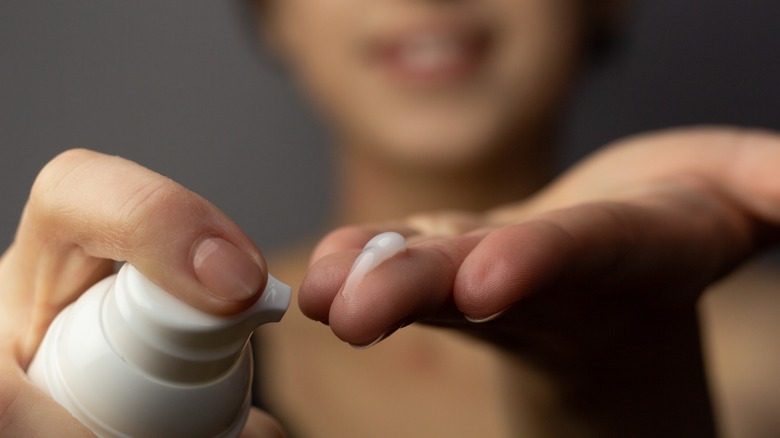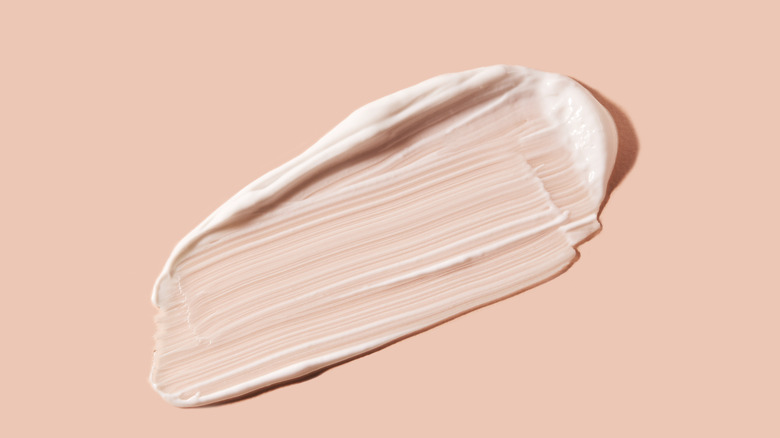Here's How To Use Hydroquinone In Your Skincare Routine
If you struggle with dark spots or an uneven skin tone, then you have most likely heard of hydroquinone. Hydroquinone is a dermatologist favorite, and it's often prescribed for the treatment of stubborn cases of hyperpigmentation, which is commonly caused by acne, sun spots, melasma, hormones, or trauma to the skin, per the American Osteopathic College of Dermatology. Many people are prone to the development of hyperpigmentation due to genetics and skin tone. Darker skin tones, for instance, are more vulnerable to discoloration and can be more difficult to treat (via Medical News Today).
Regardless of skin tone or genetic predisposition, it can be frustrating to reduce hyperpigmentation. Thankfully, however, hydroquinone is touted as a miracle ingredient for dark spots and discoloration. But does hydroquinone live up to the hype? According to the Advanced Dermatology and Skin Care Associates, yes, it absolutely does live up to the hype — when used correctly. So, here's what you need to know about hydroquinone and how to effectively incorporate this dermatologist favorite into your skincare routine.
The best way to use hydroquinone
Hydroquinone can be added to any skincare routine, but it requires consistency to see results. Here are a few tips and tricks to incorporate hydroquinone into your daily routine. You want to ensure you're using a high-quality product from a trusted source, ideally from a board-certified dermatologist. Before you use hydroquinone, it's wise to conduct a patch test to see how your skin reacts. If you don't react, then you can begin your routine.
The first thing you want to do is cleanse your skin of oil and impurities so you can ensure the product can properly absorb into the skin (via Healthline). Apply a small amount to the affected area before bed and gently rub it in until absorbed. You can apply a moisturizer after the product has been fully absorbed to help reduce mild irritation or dryness. Make sure to use sun protection to prevent further discoloration or this may affect results.
According to the American Osteopathic College of Dermatology, discontinue use and consult your dermatologist if you experience persistent side effects such as extreme irritation, redness, dryness, further discoloration, or rashes. Hydroquinone is an effective treatment option, but it can be harsh on the skin. It's, therefore, not recommended to continue use beyond five months, after which you should wait at least three months before resuming use, per Healthline. Still, if you don't notice signs of improvement after three months, you should discontinue use altogether and discuss alternative options with your dermatologist.
How does hydroquinone work?
Before you consider adding hydroquinone to your skincare routine, it's important to understand the science behind this go-to treatment. Hydroquinone is a topical skin-lightening agent that bleaches the skin by disrupting the production of melanocytes, per Healthline. Melanocytes are in charge of producing melanin, which provides pigmentation to the skin.
Though discoloration and dark spots can occur for many reasons, hyperpigmentation often stems from inflammation, as is the case with acne, allergic reactions, or trauma to the skin. In other words, the areas of redness or inflammation become darker in color due to the overproduction of melanin post-inflammation. With melasma and sun spots, the hyperpigmentation is not necessarily triggered by inflammation but rather due to changes in hormone levels and sun exposure, according to Harvard Health Publishing.
Hydroquinone, therefore, controls the transfer of melanin to the skin by reducing the production of melanocytes. Typically, this process takes about four weeks to take effect, though results vary depending on the strength of your prescription and frequency of application.


